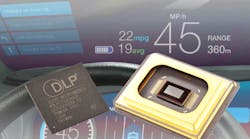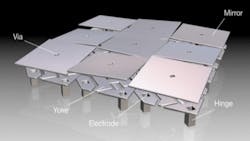Texas Instruments’ (TI) DLP unit is set to light up the latest automotive heads-up displays (HUDs), providing larger and clearer images. The DLP3000-Q1 DLP and chipset (Fig. 1) are now qualified for automotive applications.
The current crop of project systems has a more limited projection width from 4 to 6 degrees. The DLP3000-Q1 allows up to 12 degrees. It can provide depth perception of 2 to 20 meters, allowing the driver to keep their focus on the road in addition to the display. The DLP does not require polarized light as some alternatives do.
The digital micromirror device (DMD) is rated from -40° to 85° C. The 0.3-in DMD has a WVGA (wide video graphics array) resolution of 854- by 480-pixels. The DLPC120 controller is ACQ500-qualified.
A key advantage of TI’s solution is consistent operation over its extended temperature range as well as over the lifetime of the system. This is critical in automotive environments that need to operate over decades.
The DLP3000-Q1 is initially targeted at automotive HUD applications, but it can be utilized in other areas as well (such as adaptive headlights). The DMD can be used with a range of light sources, including LEDs and lasers.
TI’s DLP technology is also used in DLP Cinema projection systems ranging from tiny pico projectors to theater systems for the home and larger environments. The DMD (Fig. 2) is a MEMS-based solution that provides excellent contrast because a black pixel has no reflected light.
DMDs were developed in 1987. They have been used in everything from printers to digital signage. More recently, they have been used in 3D printers.


